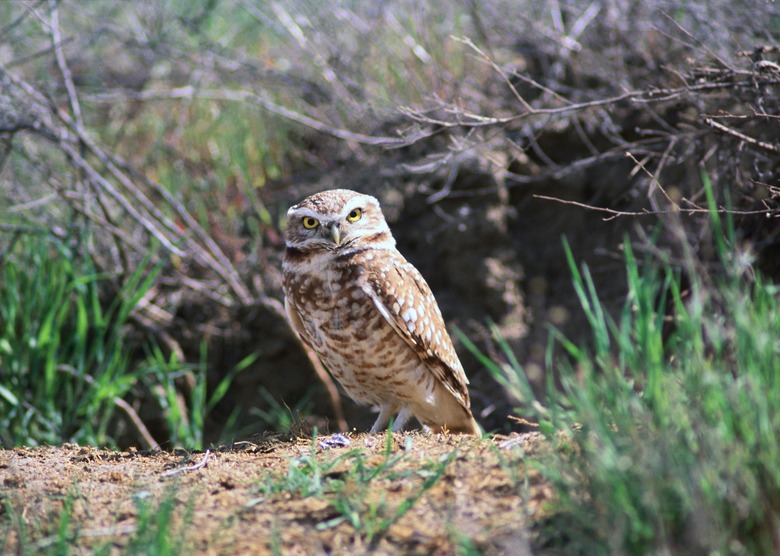The Biome And Ecosystem Of The Burrowing Owl
Picture a miniature version of an owl on stilts. That's a burrowing owl. They live in dry, open habitats among native perennial grasses. Burrowing owls nest on the ground and often occupy abandoned burrows of small mammals such as mice and squirrels. Their populations are in decline, and the species is protected by the federal Migratory Bird Treaty Act in the United States, Canada and Mexico.
Biomes
Biomes
Researchers who study ecosystems (interactions of organisms within biological communities) identify major geographic regions of the world, called biomes. Nine terrestrial biomes can be classified according to climate. The number rises when the regions are classified not just by climate but vegetation. A simple set of biomes consists of the aquatic, desert, forest, grassland and tundra. Most burrowing owls nest in grassland biomes; however, some nest in desert and forest biomes.
Distribution
Distribution
Two subspecies of burrowing owls live in North America. Athene cunicularia hypugaea (western burrowing owl) migrates between southwestern Canada and Mexico through the central and western United States. Although little is known about their migration routes, the owls arrive in the Saskatchewan province of Canada during the first week of May. Those that breed in Canada and the United States are believed to migrate south in late fall, and some are seen as far away as South America. The range-wide distribution of Athene cunicularia floridana (Florida burrowing owl) is limited to Florida and the Bahamas.
Ecosystems
Ecosystems
Burrowing owls are specialists of open areas and nest, roost and forage on short, low-density vegetation. One major difference between studying major geographic regions, or biomes, and ecosystems is the interspecific (between species) interactions and subsequent adaptations apparent at the ecosystem level. Baby ground squirrels are immune to rattlesnake venom, and to deter predators, baby burrowing owls also have a special adaptation — they hiss, mimicking the sound of a rattlesnake. One of most important ecosystems for the owls, the native grassland in California, represents one of the most endangered ecosystems in the nation. Since the 1700s, the acreage of the grassland declined from 22 million to 2 million.
Habitat Loss
Habitat Loss
Burrowing owls depend on a habitat of native grasses to survive. As this habitat is lost to agricultural and urban development, their populations decline. Some burrowing owls are seen in human-modified environments and urban open spaces. Successfully managing their habitats will help the species survive.
Ecosystems are mapped from a macro, biome-level scale such as a grassland biome to a micro, habitat-level scale such as an open area within an ecosystem. With the goal of managing declining wildlife populations more effectively, researchers at U.S. Geological Survey are involved in efforts to classify and map global ecosystems in a standardized way and at scales appropriate for wildlife research, conservation and management.
References
- Marietta College: Biomes of the World
- University of California Museum of Paleontology: The World's Biomes
- U.S. Fish and Wildlife Service: Status Assessment and Conservation Plan for the Western Burrowing Owl
- U.S. Forrest Service: Index of Species Information
- Grasslands: Managing California's Grassland Ecosystems for Athene Cunicularia Hypugaea
- Defenders of Wildlife: Basic Facts About Burrowing Owls
- British Columbia Ministry of Environment: Burrowing Owl
- U.S. Geological Survey: Ecosystems Mapping
Cite This Article
MLA
Tides, Ocean. "The Biome And Ecosystem Of The Burrowing Owl" sciencing.com, https://www.sciencing.com/biome-ecosystem-burrowing-owl-22354/. 24 April 2017.
APA
Tides, Ocean. (2017, April 24). The Biome And Ecosystem Of The Burrowing Owl. sciencing.com. Retrieved from https://www.sciencing.com/biome-ecosystem-burrowing-owl-22354/
Chicago
Tides, Ocean. The Biome And Ecosystem Of The Burrowing Owl last modified August 30, 2022. https://www.sciencing.com/biome-ecosystem-burrowing-owl-22354/
